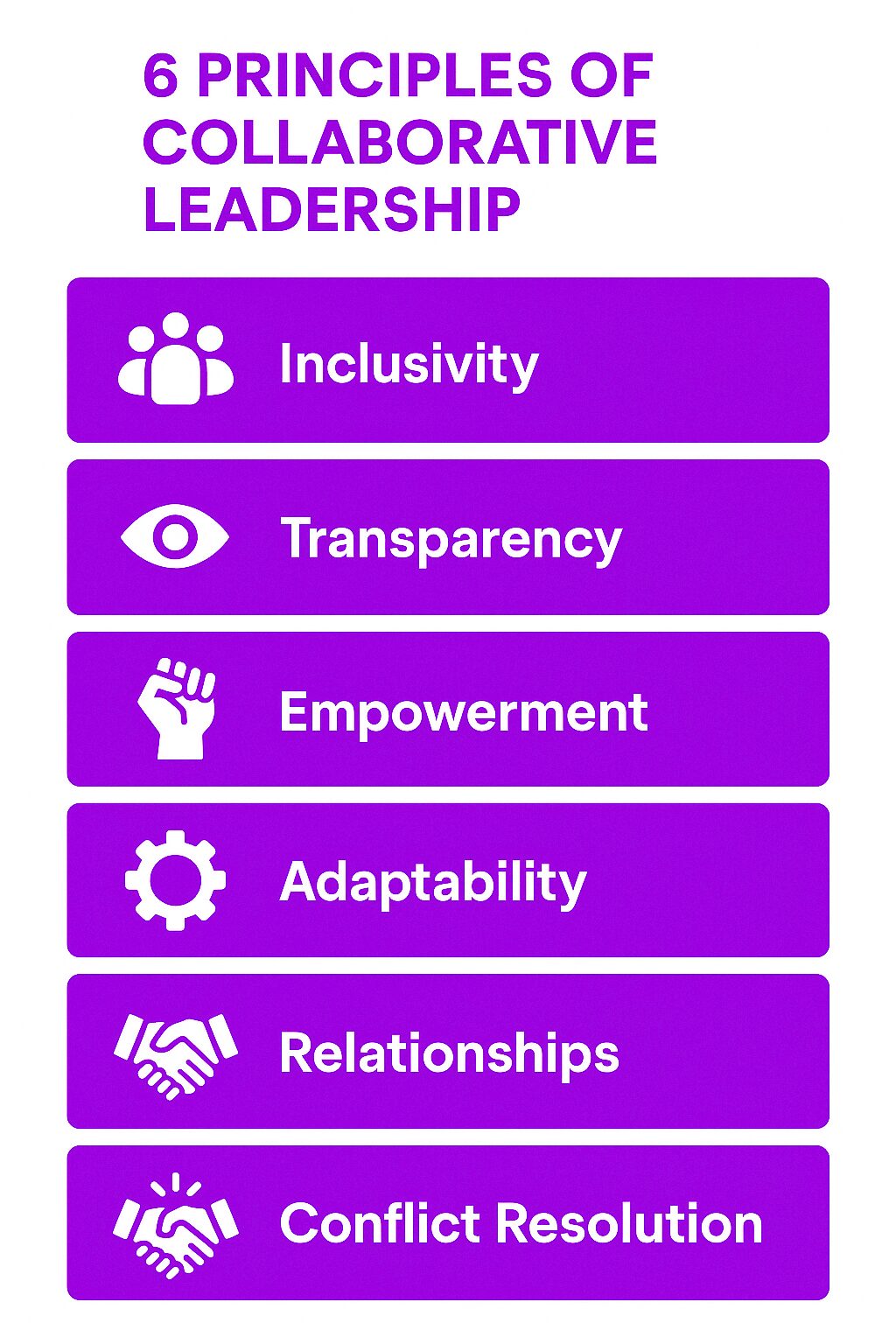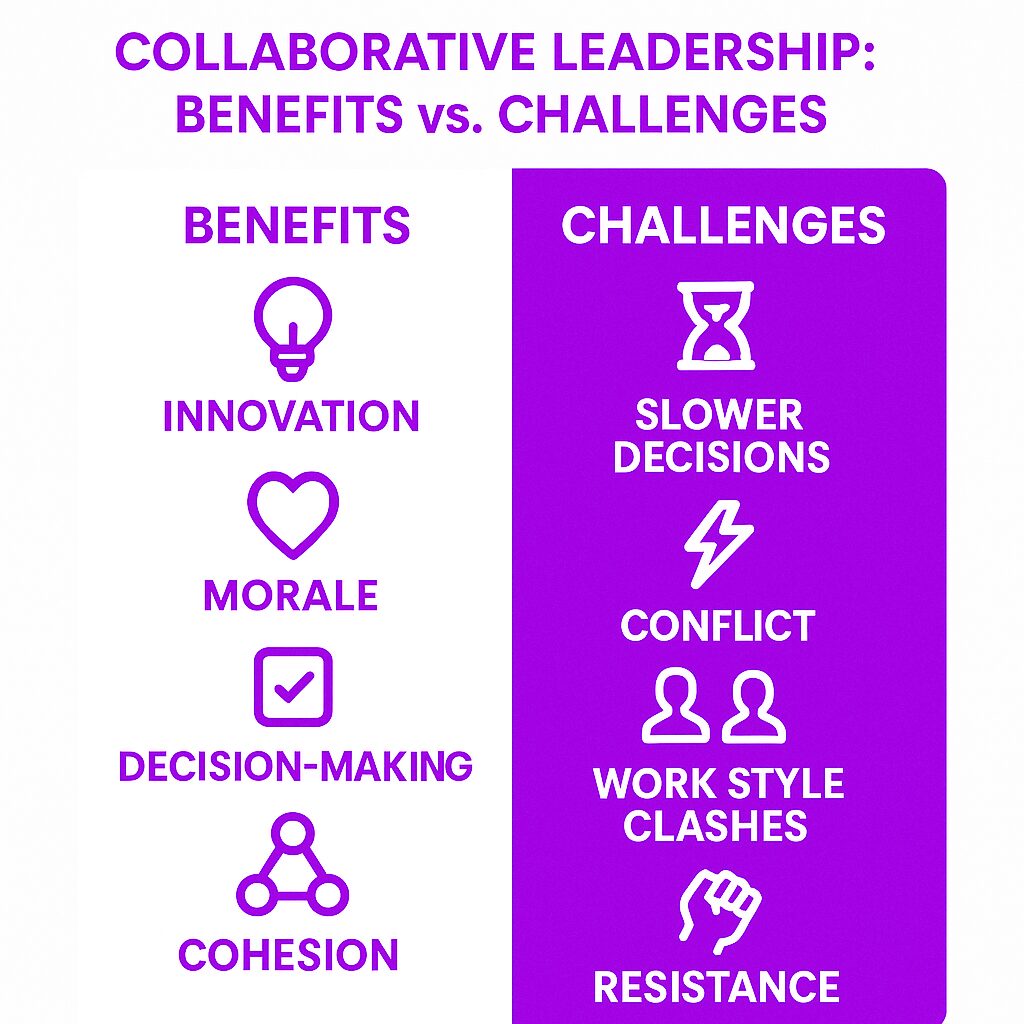What is Collaborative Leadership Style?
Collaborative leadership is a management style that encourages teamwork, shared decision-making, and problem-solving across an organization. Rather than relying on a traditional top-down structure, collaborative leaders engage employees at all levels, ensuring that ideas flow freely, knowledge is shared, and teams work together to achieve business goals.
This collaborative approach fosters an environment where transparency, trust, and mutual respect drive business success. It ensures that employees feel valued and heard, leading to increased engagement and productivity. Organizations that adopt collaborative leadership benefit from more creative problem-solving, stronger workplace relationships, and greater adaptability in changing environments.
How to Become a Collaborative Leader
Adopting a collaborative leadership style requires a shift in mindset and daily practices. A collaborative leadership approach is crucial in educational programs that focus on corporate and organizational communication, as it fosters teamwork and enhances organizational culture through experiential learning and practical applications in real-world scenarios. Six key principles define this leadership approach:
1. Embrace Inclusivity
Engage all team members in decision-making by recognizing and respecting the diverse perspectives of all groups involved. Encourage employees to voice their perspectives, ensuring that ideas from diverse backgrounds are considered.
2. Practice Transparency
Share goals, challenges, and strategic initiatives openly with your team. Transparency builds trust and ensures that everyone is aligned with the company’s objectives.
3. Empower Individuals with Leadership Skills
Give employees ownership over their tasks. Delegating responsibility and encouraging autonomy creates a sense of accountability and engagement.
4. Encourage Adaptability
A collaborative leader welcomes change and encourages teams to innovate and experiment with new ideas. By questioning their own ideas, leaders foster an environment where innovation and adaptability can thrive, preparing organizations to navigate uncertainty.
5. Build Strong Relationships
Develop meaningful connections within the team. Understanding employees’ strengths, motivations, and challenges helps foster a positive work culture.
6. Promote Conflict Resolution
Differences in opinions are natural. A collaborative leader ensures that conflicts are resolved constructively, encouraging open dialogue and mutual understanding.
Benefits of Collaborative Leadership
Organizations that implement collaborative leadership see improvements in workplace culture, team effectiveness, and overall business performance. Collaborative leadership helps enhance creativity and effective problem-solving by creating an environment where diverse ideas can converge. Key benefits include:
-
Enhanced Decision-Making – Encouraging multiple perspectives leads to well-rounded, informed decisions.
-
Improved Employee Morale – Employees feel valued when their input is considered, leading to increased job satisfaction.
-
Increased Innovation – Collaboration sparks creativity, bringing together diverse ideas and expertise.
-
Stronger Team Cohesion – Open communication breaks down silos and fosters trust between departments.
-
Higher Adaptability – Teams that collaborate effectively respond more quickly to industry changes and disruptions.
Challenges of Collaborative Leadership
Despite its advantages, collaborative leadership presents challenges that must be managed carefully. Distributed teams, for instance, face communication barriers and feelings of isolation, but collaborative leadership can address these issues by fostering inclusivity, enhancing communication, and creating a supportive environment that encourages team members to feel valued and connected despite their physical distances.
1. Slower Decision-Making
Involving multiple stakeholders in decision-making can slow down processes. Leaders must balance inclusivity with the need for efficiency.
2. Potential for Conflict
Diverse perspectives can lead to disagreements. Leaders must mediate conflicts and ensure that discussions remain productive.
3. Managing Different Work Styles
Not all employees communicate or collaborate in the same way. Leaders must navigate varying personalities and work preferences.
4. Resistance to Change
Some employees may be hesitant to embrace a collaborative culture, especially if they are accustomed to a hierarchical leadership style.
Strategies for Implementing Collaborative Leadership
To successfully integrate collaborative leadership, organizations should adopt the following strategies:
A collaborative enterprise is crucial in fostering cooperative relationships towards achieving shared goals.
1. Promote Cross-Functional Collaboration
Encourage teams from different departments to work together on projects. Breaking down silos improves coordination and strengthens relationships between teams.
2. Provide Training and Resources
Equip employees with leadership skills through hands-on experiences in communication, conflict resolution, and teamwork. Leadership development programs can help reinforce collaboration best practices.
3. Lead by Example
Demonstrate collaborative behavior by actively listening to employees, encouraging participation, and fostering a culture of inclusivity. In a leadership role, it is crucial to adapt to the evolving characteristics and requirements of collaborative leaders by engaging and integrating diverse perspectives.
4. Establish Clear Goals and Expectations
Ensure that employees understand their roles, responsibilities, and objectives. Clearly defined goals prevent confusion and misalignment.
5. Encourage Innovation and Experimentation
Create an environment where employees feel safe to take risks, suggest new ideas, and challenge existing processes.
Best Practices for Effective Collaborative Leadership
For collaboration to be effective, leaders should:
-
Foster a Trust-Based Culture – Encourage open communication and honesty. Effective management practice plays a crucial role in breaking down organizational silos and fostering teamwork among executives and staff.
-
Leverage Technology – Use collaboration tools like Slack, Microsoft Teams, and project management platforms to streamline workflows.
-
Recognize and Reward Contributions – Acknowledge employees who actively participate in collaborative efforts.
-
Encourage Continuous Learning – Provide opportunities for professional development and leadership growth.
Real-World Examples of Collaborative Leadership
Companies that implement collaborative leadership often see positive results. A leadership team in a traditional hierarchical setup makes unilateral decisions without input from others, whereas in a collaborative approach, the leadership team works together with various departments to make inclusive and transparent decisions, fostering unity and innovation within the organization.
Here are three examples:
1. Google
Google fosters a culture of collaboration through its open office spaces, brainstorming sessions, and inclusive decision-making. Employees are encouraged to contribute ideas regardless of their position.
2. Airbnb
Airbnb emphasizes cross-functional teamwork by encouraging departments to collaborate on projects that enhance customer experience and operational efficiency.
3. Microsoft
Microsoft transitioned from a competitive, siloed culture to a collaborative one under CEO Satya Nadella. By prioritizing teamwork and shared goals, the company has driven innovation and improved internal communication.
The Future of Collaborative Leadership
As businesses continue to evolve, collaborative leadership will become even more critical. Collaborative leadership means an approach to managing teams that emphasizes teamwork, cooperation, and shared decision-making. The rise of remote work, digital collaboration tools, and cross-functional teams highlights the need for leaders who can foster teamwork and adaptability.
Organizations that embrace this leadership approach will be better positioned to attract top talent, drive innovation, and maintain a competitive edge in a rapidly changing business environment.








